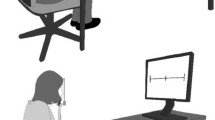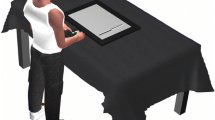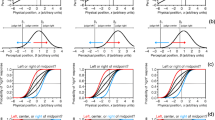Abstract
The line bisection task—commonly used as a clinical measure of unilateral neglect—requires participants to place a mark on a horizontal line to indicate where they think centre is. In general, results suggest that the allocation of attention mediates bisection. In addition, previous research shows that participants rarely explore the endpoints of lines, suggesting that peripheral visual information informs bisection. Here, we examined bisection performance under conditions in which differing levels of ‘noise’ were introduced to the line to examine the hypothesis that the fidelity and symmetry of peripheral information would inform performance. Contrary to our expectations, results showed that symmetrically introducing noise to the line biased bisection further leftward compared to a ‘no-noise’ condition. Furthermore, asymmetrical noise increased leftward bisection errors primarily when lines were presented in left space or when the greater amount of noise was on the left half of the line. These results indicate that the fidelity of peripheral visual information mediates bisection behaviour that is already biased leftwards probably due to right hemisphere attentional mechanisms.



Similar content being viewed by others
References
Bartolomeo P, Chokron S (1999) Egocentric frame of reference: Its role in spatial bias after right hemisphere lesions. Neuropsychologia 37:881–894
Bisiach E, Pizzamiglio L, Nico D, Antonucci G (1996) Beyond unilateral neglect. Brain 119:851–857
Bowers D, Heilman KM (1980) Pseudoneglect: effects of hemispace on a tactile line bisection task. Neuropsychologia 18:491–498
Brodie EE, Dunn E (2005) Visual line bisection in sinistrals and dextrals as a function of hemispace, hand, and scan direction. Brain Cogn 58:149–156
Brodie EE, Pettigrew LE (1996) Is left always right? Directional deviation in visual line bisection as a function of hand and initial scanning direction. Neuropsychologia 34:467–470
Chiba Y, Yamaguchi A, Eto F (2006) Assessment of sensory neglect: a study using moving images. Neuropsychol Rehabil 16:641–652
Chokron S (2002) On the origin of free-viewing perceptual asymmetries. Cortex 38:109–112
Chokron S, Bartolomeo P, Perenin MT, Helft G, Imbert M (1998) Scanning direction and line bisection: a study of normal subjects and unilateral neglect patients with opposite reading habits. Cogn Brain Res 7:173–178
Corbetta M, Shulman GL (2002) Control of goal-directed and stimulus-driven attention in the brain. Nat Rev Neurosci 3:201–215
Corbetta M, Miezin FM, Shulman GL, Petersen SE (1993) A PET study of visuospatial attention. J Neurosci 13:1202–1226
Danckert J, Ferber S (2006) Revisiting unilateral neglect. Neuropsychologia 44:987–1006
Foxe JJ, McCourt M, Javitt DC (2003) Right hemisphere control of visuospatial attention: line-bisection judgments evaluated with high-density electrical mapping and source analysis. Neuroimage 19:710–726
Gianotti G, D’Erme P, Bartolomeo P (1991) Early orientation of attention toward the half space ipsilateral to the lesion in patients with unilateral brain damage. J Neurol Neurosurg Psychiatry 54:1082–1089
Heilman KM, van den Abell T (1980) Right hemisphere dominance for attention: the mechanism underlying hemispheric asymmetries of inattention. Neurology 30:327–330
Heilman KM, Watson RT, Valenstein E (2003) Neglect and related disorders. In: Heilman KM, Valenstein E (eds) Clinical neuropsychology, 3rd edn. Oxford University Press, New York
Hurwitz M, Valadao D, Danckert J (under consideration) Dynamic judgments of spatial extent: dissociating hand-centered and gaze-centered reference frames. Exp Brain Res
Ishiai S, Furukawa H, Tsukagoshi H (1987) Eye-fixation patterns in homonymous hemianopia and unilateral spatial neglect. Neuropsychologia 26:675–679
Ishiai S, Furukawa H, Tsukagoshi H (1989) Visuospatial processes of line bisection and the mechanisms underlying unilateral spatial neglect. Brain 112:1485–1502
Jewell G, McCourt M (2000) Pseudoneglect: a review and meta-analysis of performance factors in line bisection tasks. Neuropsychologia 38:93–110
Kinsbourne M (1970) The cerebral basis of lateral asymmetries in attention. Acta Psychol 33:193–201
McCourt M, Jewell G (1999) Visuospatial attention in line bisection: stimulus modulation of pseudoneglect. Neuropsychologia 37:843–855
McCourt M, Olafson C (1997) Cognitive and perceptual influences on visual line bisection: psychophysical and chronometric analyses of pseudoneglect. Neuropsychologia 35:369–380
McCourt M, Garlinghouse M, Slater J (2000) Centripetal versus centrifugal bias in visual line bisection: focusing attention on two hypotheses. Front Biosci 5:D58–D71
McIntosh R, Schindler I, Birchall D, Milner A (2005) Weights and measures: a new look at bisection behaviour in neglect. Cogn Brain Res 25:833–850
Mesulam MM (1981) A cortical network for directed attention and unilateral neglect. Ann Neurol 10:309–325
Mesulam MM (1999) Spatial attention and neglect: parietal, frontal and cingulate contributions to the mental representation and attentional targeting of salient extrapersonal events. Philos Trans R Soc Lond B Biol Sci 354:1325–1346
Milner AD, Brechmann M, Pagliarini L (1992) To halve and to halve not—an analysis of line bisection judgments in normal subjects. Neuropsychologia 30:515–526
Nichelli P, Rinaldi M, Cubelli R (1989) Selective spatial attention and length representation in normal subjects and in patients with unilateral spatial neglect. Brain Cogn 9:57–70
Niemeier M, Stojanoski B, Greco AL (2007) Influences of time and spatial frequency on the perceptual bias: Evidence for competition between hemispheres. Neuropsychologia 45:1029–1040
Niemeier M, Singh VV, Keough M, Akbar N (2008) The perceptual consequences of the attention bias: evidence for distractor removal. Exp Brain Res 189:411–420
Posner MI, Walker JA, Friedrich FJ, Rafal RD (1984) Effects of parietal injury on covert orienting of attention. J Neurosci 4:1863–1874
Reuter-Lorenz PA, Posner MI (1990) Components of neglect from right-hemisphere damage: an analysis of line bisection. Neuropsychologia 28:327–333
Reuter-Lorenz PA, Kinsbourne M, Moscovitch M (1990) Hemispheric control of spatial attention. Brain Cogn 12:240–266
Rueckert L, Deravanesian A, Baboorian D, Lacalamita A, Repplinger M (2002) Pseudoneglect and the cross-over effect. Neuropsychologia 40:162–173
Schuett S, Kentridge RW, Zihl J, Heywood CA (2009) Is the origin of the line bisection error purely visual? Evidence from eye movements in simulated hemianopia. Vis Res 49:1668–1680
Yantis S, Serences JT (2003) Cortical mechanisms of space-based and object-based attentional control. Curr Op Neurobiol 13:187–193
Author information
Authors and Affiliations
Corresponding author
Rights and permissions
About this article
Cite this article
Valadao, D.F., Hurwitz, M. & Danckert, J. Examining the influence of ‘noise’ on judgements of spatial extent. Exp Brain Res 207, 157–164 (2010). https://doi.org/10.1007/s00221-010-2449-2
Received:
Accepted:
Published:
Issue Date:
DOI: https://doi.org/10.1007/s00221-010-2449-2




